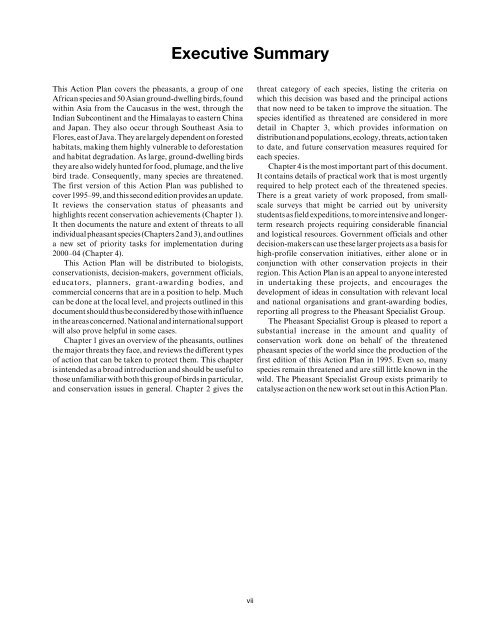Pheasants: Status Survey and Conservation Action Plan ... - IUCN
Pheasants: Status Survey and Conservation Action Plan ... - IUCN
Pheasants: Status Survey and Conservation Action Plan ... - IUCN
Create successful ePaper yourself
Turn your PDF publications into a flip-book with our unique Google optimized e-Paper software.
Executive Summary<br />
This <strong>Action</strong> <strong>Plan</strong> covers the pheasants, a group of one<br />
African species <strong>and</strong> 50 Asian ground-dwelling birds, found<br />
within Asia from the Caucasus in the west, through the<br />
Indian Subcontinent <strong>and</strong> the Himalayas to eastern China<br />
<strong>and</strong> Japan. They also occur through Southeast Asia to<br />
Flores, east of Java. They are largely dependent on forested<br />
habitats, making them highly vulnerable to deforestation<br />
<strong>and</strong> habitat degradation. As large, ground-dwelling birds<br />
they are also widely hunted for food, plumage, <strong>and</strong> the live<br />
bird trade. Consequently, many species are threatened.<br />
The first version of this <strong>Action</strong> <strong>Plan</strong> was published to<br />
cover 1995–99, <strong>and</strong> this second edition provides an update.<br />
It reviews the conservation status of pheasants <strong>and</strong><br />
highlights recent conservation achievements (Chapter 1).<br />
It then documents the nature <strong>and</strong> extent of threats to all<br />
individual pheasant species (Chapters 2 <strong>and</strong> 3), <strong>and</strong> outlines<br />
a new set of priority tasks for implementation during<br />
2000–04 (Chapter 4).<br />
This <strong>Action</strong> <strong>Plan</strong> will be distributed to biologists,<br />
conservationists, decision-makers, government officials,<br />
educators, planners, grant-awarding bodies, <strong>and</strong><br />
commercial concerns that are in a position to help. Much<br />
can be done at the local level, <strong>and</strong> projects outlined in this<br />
document should thus be considered by those with influence<br />
in the areas concerned. National <strong>and</strong> international support<br />
will also prove helpful in some cases.<br />
Chapter 1 gives an overview of the pheasants, outlines<br />
the major threats they face, <strong>and</strong> reviews the different types<br />
of action that can be taken to protect them. This chapter<br />
is intended as a broad introduction <strong>and</strong> should be useful to<br />
those unfamiliar with both this group of birds in particular,<br />
<strong>and</strong> conservation issues in general. Chapter 2 gives the<br />
threat category of each species, listing the criteria on<br />
which this decision was based <strong>and</strong> the principal actions<br />
that now need to be taken to improve the situation. The<br />
species identified as threatened are considered in more<br />
detail in Chapter 3, which provides information on<br />
distribution <strong>and</strong> populations, ecology, threats, action taken<br />
to date, <strong>and</strong> future conservation measures required for<br />
each species.<br />
Chapter 4 is the most important part of this document.<br />
It contains details of practical work that is most urgently<br />
required to help protect each of the threatened species.<br />
There is a great variety of work proposed, from smallscale<br />
surveys that might be carried out by university<br />
students as field expeditions, to more intensive <strong>and</strong> longerterm<br />
research projects requiring considerable financial<br />
<strong>and</strong> logistical resources. Government officials <strong>and</strong> other<br />
decision-makers can use these larger projects as a basis for<br />
high-profile conservation initiatives, either alone or in<br />
conjunction with other conservation projects in their<br />
region. This <strong>Action</strong> <strong>Plan</strong> is an appeal to anyone interested<br />
in undertaking these projects, <strong>and</strong> encourages the<br />
development of ideas in consultation with relevant local<br />
<strong>and</strong> national organisations <strong>and</strong> grant-awarding bodies,<br />
reporting all progress to the Pheasant Specialist Group.<br />
The Pheasant Specialist Group is pleased to report a<br />
substantial increase in the amount <strong>and</strong> quality of<br />
conservation work done on behalf of the threatened<br />
pheasant species of the world since the production of the<br />
first edition of this <strong>Action</strong> <strong>Plan</strong> in 1995. Even so, many<br />
species remain threatened <strong>and</strong> are still little known in the<br />
wild. The Pheasant Specialist Group exists primarily to<br />
catalyse action on the new work set out in this <strong>Action</strong> <strong>Plan</strong>.<br />
vii
















